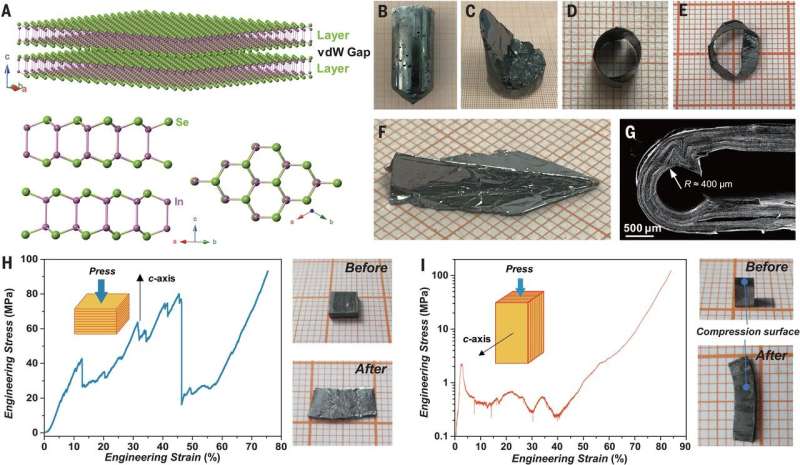July 31, 2020 report
Researchers find crystals of indium selenide have exceptional flexibility

A team of researchers affiliated with multiple institutions in China and one in the U.S. has found that semiconducting crystals of indium selenide (InSe) have exceptional flexibility. In their paper published in the journal Science, the group describes testing samples of InSe and what they learned about the material. Xiaodong Han with Beijing University of Technology has published a Perspective piece outlining the work by the team in China in the same journal issue.
As the researchers note, most semiconductors are rigid, which means they are difficult to use in applications that require varied surfaces or bending. This has presented a problem for portable device makers as they attempt to respond to user demand for bendable electronics. In this new effort, the researchers in China have found one semiconductor, InSe, that is not only flexible, but is so pliable that it can be processed using rollers.
InSe, as its name implies, is a compound made from indium (a metal element often used in touchscreens) and selenium (a non-metal element). Selenium is also a 2-D semiconductor, and has come under scrutiny after researchers discovered that its bandgap matched the visible region in the electromagnetic spectrum. It has previously been studied for use in specialty optoelectronic applications. In this new effort, the researchers looked into the possibility of using it as a semiconductor in bendable portable electronic devices.
In testing the material, the researchers found that its compressive strain was approximately 80 percent at room temperature. They also found that a single flake made from approximately 105 layers of the material was still extremely bendable. Additional testing showed that bulk InSe had a bandgap of approximately 1.26 eV at room temperature and a honeycombed hexagonal crystalline structure. Its layers were formed via Se-In-In-Se covalent bonds, and the layers were held together by Se-Se Van der Waals interactions. Perhaps most importantly, the researchers found that the material could be mass-produced using thermal-mechanical rolling, where a succession of increasingly small rollers were used to flatten and widen the material into thin continuous sheets.
The researchers conclude by suggesting InSe may be suitable for use in developing next-generation deformable or even flexible electronic devices.
More information: Tian-Ran Wei et al. Exceptional plasticity in the bulk single-crystalline van der Waals semiconductor InSe, Science (2020). DOI: 10.1126/science.aba9778
Journal information: Science
© 2020 Science X Network




















